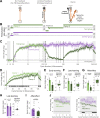Reexposure to a sensorimotor perturbation produces opposite effects on explicit and implicit learning processes
- PMID: 33667219
- PMCID: PMC7968744
- DOI: 10.1371/journal.pbio.3001147
Reexposure to a sensorimotor perturbation produces opposite effects on explicit and implicit learning processes
Abstract
The motor system demonstrates an exquisite ability to adapt to changes in the environment and to quickly reset when these changes prove transient. If similar environmental changes are encountered in the future, learning may be faster, a phenomenon known as savings. In studies of sensorimotor learning, a central component of savings is attributed to the explicit recall of the task structure and appropriate compensatory strategies. Whether implicit adaptation also contributes to savings remains subject to debate. We tackled this question by measuring, in parallel, explicit and implicit adaptive responses in a visuomotor rotation task, employing a protocol that typically elicits savings. While the initial rate of learning was faster in the second exposure to the perturbation, an analysis decomposing the 2 processes showed the benefit to be solely associated with explicit re-aiming. Surprisingly, we found a significant decrease after relearning in aftereffect magnitudes during no-feedback trials, a direct measure of implicit adaptation. In a second experiment, we isolated implicit adaptation using clamped visual feedback, a method known to eliminate the contribution of explicit learning processes. Consistent with the results of the first experiment, participants exhibited a marked reduction in the adaptation function, as well as an attenuated aftereffect when relearning from the clamped feedback. Motivated by these results, we reanalyzed data from prior studies and observed a consistent, yet unappreciated pattern of attenuation of implicit adaptation during relearning. These results indicate that explicit and implicit sensorimotor processes exhibit opposite effects upon relearning: Explicit learning shows savings, while implicit adaptation becomes attenuated.
Conflict of interest statement
The authors have declared that no competing interests exist.
Figures



References
-
- Ebbinghaus H. Memory (ha ruger & ce bussenius, trans.). New York: Teachers College (Original work published 1885). 1913;39.
Publication types
MeSH terms
Grants and funding
LinkOut - more resources
Full Text Sources
Other Literature Sources

